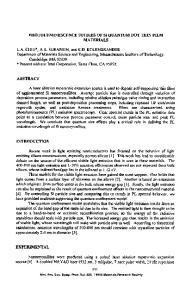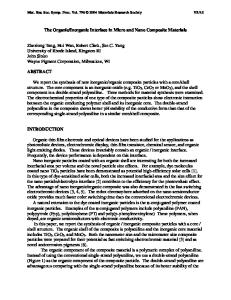Inorganic Quantum Dot - Organic Dendrimer Nanocomposite Materials
- PDF / 749,711 Bytes
- 6 Pages / 417.6 x 639 pts Page_size
- 74 Downloads / 394 Views
ABSTRACT Semiconductor quantum dots are of great current interest for their optical properties. We have developed a method for preparing CdS quantum dots in commercially available PAMAM Starburst dendrimers. The resulting CdS-dendrimer nanocomposites are exceptionally stable and emit brightly in the blue. The size of the dendrimer (its "generation") has a surprisingly small effect on the optical properties of the resulting nanocomposites. The dot-dendrimer nanocomposites can be captured in a silica sol-gel matrix to yield a stable, bright blue-emitting glass. INTRODUCTION The use of the well-defined quasi-spherical organic polymers, PAMAM Starburst dendrimers, in materials synthesis has become extremely popular [1-7]. The repeating structure of these molecules is
NH2
2
core
GO
GI
G2
G3
G4
where GN refers to the "generation number" of the dendrimer. The surface terminal groups for an integral generation number are primary amines. The dashed lines from each tertiary nitrogen are shorthand for the repetition of the entire structure to the right of that nitrogen at that point. Thus, the G2 dendrimer has 16 surface amine groups, G3 has 32 surface amine groups, and G4 has 64 surface amine groups. The G4 molecule is -4 nm in diameter from molecular modeling and dynamic light scattering measurements in methanol solution [4]. 439
Mat. Res. Soc. Symp. Proc. Vol. 576 0 1999 Materials Research Society
The recent flurry of materials syntheses with these polymers has focused on the use of them as stabilizing and solubilizing agents for inorganic nanoparticles, chiefly metals [1-3, 5-7] but also semiconductors [4]. The dendrimer can stabilize the formation of extremely small metal clusters intramolecularly by coordination of metal ions to the interior ketone oxygens or tertiary nitrogens; alternatively, the dendrimer can stabilize the formation of nanoclusters intermolecularly by coordination of metal ions to the surface amines of multiple dendrimers. The inorganic nanocluster - organic dendrimer nanocomposites that have been formed can take on the good solubility and deposition properties of the dendrimers themselves. Here we examine CdS nanoparticle formation in the presence of G2, G3 and G4 dendrimers, based on the previous success with G4 [4]. The entire nanocomposite can be captured in a silica sol gel to yield a stable optical material. EXPERIMENTAL Nanocomposite Synthesis. The preparation of the "standard" CdS-dendrimer nanocomposite has been published [4]. This method was adapted for experiments as a function of dendrimer concentration: A stock solution of 2 x 10-3 M Cd(N0 3)2 4H 20 was prepared in methanol, and another stock solution of 2 x 10-3 M Na 2S was also prepared in methanol. G2, G3 and G4 dendrimers (Aldrich) were provided as 10% by weight solutions in methanol. Stock dendrimer solutions were made by diluting the commercial product to yield solutions 1.1 x 10-4 M in dendrimer. In a typical synthesis, 10 mL of either the dendrimer stock solution or one diluted with methanol, as appropriate, were coole
Data Loading...











